Validating CFD Predictions of Flow over an Escarpment Using Ground-Based and Airborne Measurement Devices
Abstract
1. Introduction
2. Methods
2.1. Numerical Model
2.2. Computational Set Up and Mesoscale Forcing
3. Test Site and Measurements
3.1. Test Site
3.2. Measurements
4. Results and Discussion
4.1. Comparison of Wind and Turbulences Quantities with the Tower and EC Measurements
4.2. Comparison with the UAS Measurements
4.2.1. Wind Speed, Wind Direction and Inclination Angles
4.2.2. Stability Considerations
- Both days have a similar flow structure with a wind direction almost perpendicular to the escarpment. The main differences are the wind speed levels: strong and calm wind condition for the first and second day, respectively. The simulated wind speed and wind direction are in accordance with the tower measurements, except for some specific times. During the flight campaigns, values for mean absolute error of 2.00 and 0.74 are found for the first and second day, respectively. The tower, positioned 60 m behind the forest, clearly shows the impact of the forest with a wind speed in the lower levels (10 m a.g.l.) strongly reduced. The reduction is higher for 22 September, where the wind speed values at the lower cup are about one third of the one at 100 m, on average.
- The turbulence is evaluated in terms of horizontal turbulence intensity. The model simulates reasonably well at the upper levels but large discrepancies are observed in lower altitudes compared to the tower measurements. This may be directly linked to the canopy model. Possible future improvements require a deeper investigation on the plant canopy and the turbulence model. The influence of the vertical turbulence intensity is not considered in this paper, as no sonic anemometers were available at that time. Further work with the newly installed sonics is required to provide an accurate representation of the turbulence, including the vertical turbulence intensity.
- The UAS measurements are used for the model validation. In order to avoid any temporal averaging, a real-time strategy is applied, where the model follows spatially and temporally the aircraft. An accelerated flow is numerically and experimentally found over the escarpment. The model slightly over-predicts the wind speeds at higher levels for the first day but still matches very well the UAS measurements. The flow structure remains the same, despite a range of different velocities.
- Changes in wind direction at turbine heights can be easily measured by the MASC. At the WINSENT test-site, the wind turned counter-clockwise with height for both days, corresponding to a backing wind.
- Sonic anemometers mounted on a tower can provide the inclination angles. However these measurements are limited to the tower locations, and there can be significant discrepancies between the inclination angle at the tower location and the one at the turbine location. The MASC can overcome this problem and be used to probe the horizontal extent of an area with negative vertical wind, for example. Upward movements over and straight after the escarpment are observed. The inclination angles at an altitude of about 200 m are smaller but still not equal to 0, indicating a flow still influenced by the orography and topography. Inclination angles of 5 and 2, at the future turbine location, are found for the first and second day, respectively. The test-site has been intentionally placed at a location that offers high inclination angles.
- The stability of the atmosphere can be described based on tower measurements, but the UAS offers the opportunity to sample at higher elevations. The calculated and simulated potential temperature profiles are in accordance with a near neutral ABL on the first day. The second day, dominated by a more convective surface layer, at the test-site is not well simulated. Indeed, the superadiabatic layer next to the ground is numerically underestimated. The temperature values at the ground in the OpenFOAM model are obtained by reading the surface heat fluxes from the WRF model and the low resolution (150 m) may be the reason of this underestimation. In future works, it will be interesting to nudge the CFD model with the EC measurements for the ground temperatures. The bulk Richardson values show a systematic drop behind the escarpment for layers near the ground and reveals thermodynamic instabilities.
5. Conclusions
Author Contributions
Funding
Acknowledgments
Conflicts of Interest
References
- Council of the European Union. Proposal for a Regulation of the European Parliament and of the Council Establishing the Framework for Achieving Climate Neutrality and Amending Regulation (EU) 2018/1999 (European Climate Law); Council of the European Union: Brussels, Belgium, 2020.
- Fraile, D.; Komusanay, I. Wind Energy in Europe: Outlook to 2023; Technical Report; WIND Europe: Brussels, Belgium, 2019. [Google Scholar]
- Jackson, P.S.; Hunt, J.C.R. Turbulent wind flow over a low hill. Q. J. R. Meteorol. Soc. 1975, 101, 929–955. [Google Scholar] [CrossRef]
- Foken, T. 50 Years of the Monin–Obukhov Similarity Theory. Bound. Layer Meteorol. 2006, 119, 431–447. [Google Scholar] [CrossRef]
- Haupt, S.E.; Kosovic, B.; Shaw, W.; Berg, L.K.; Churchfield, M.; Cline, J.; Draxl, C.; Ennis, B.; Koo, E.; Kotamarthi, R.; et al. On Bridging A Modeling Scale Gap: Mesoscale to Microscale Coupling for Wind Energy. Bull. Am. Meteorol. Soc. 2019, 100, 2533–2550. [Google Scholar] [CrossRef]
- Dudhia, J. A history of mesoscale model development. Asia-Pac. J. Atmos. Sci. 2014, 50, 121–131. [Google Scholar] [CrossRef]
- Jiménez, P.A.; Dudhia, J. Improving the Representation of Resolved and Unresolved Topographic Effects on Surface Wind in the WRF Model. J. Appl. Meteorol. Climatol. 2011, 51, 300–316. [Google Scholar] [CrossRef]
- Flores-Maradiaga, A.; Benoit, R.; Masson, C. Enhanced modelling of the stratified atmospheric boundary layer over steep terrain for wind resource assessment. J. Phys. Conf. Ser. 2019, 1222, 012005. [Google Scholar] [CrossRef]
- Tewari, M.; Kusaka, H.; Chen, F.; Coirier, W.J.; Kim, S.; Wyszogrodzki, A.A.; Warner, T.T. Impact of coupling a microscale computational fluid dynamics model with a mesoscale model on urban scale contaminant transport and dispersion. Atmos. Res. 2010, 96, 656–664. [Google Scholar] [CrossRef]
- Kwak, K.H.; Baik, J.J.; Ryu, Y.H.; Lee, S.H. Urban air quality simulation in a high-rise building area using a CFD model coupled with mesoscale meteorological and chemistry-transport models. Atmos. Environ. 2015, 100, 167–177. [Google Scholar] [CrossRef]
- Duraisamy, V.J.; Dupont, E.; Carissimo, B. Downscaling wind energy resource from mesoscale to microscale model and data assimilating field measurements. J. Phys. Conf. Ser. 2014, 555, 012031. [Google Scholar] [CrossRef]
- Klaas, T.; Pauscher, L.; Callies, D. LiDAR-mast deviations in complex terrain and their simulation using CFD. Meteorol. Z. 2015, 24, 591–603. [Google Scholar] [CrossRef]
- Santos, P.; Mann, J.; Vasiljevic, N.; Courtney, M.; Sanz Rodrigo, J.; Cantero, E.; Borbón, F.; Martínez-Villagrasa, D.; Martí, B.; Cuxart, J. The Alaiz Experiment (ALEX17): Wind Field and Turbulent Fluxes in a Large-Scale and Complex Topography with Synoptic Forcing; Technical University of Denmark: Kongens Lyngby, Denmark, 2019. [Google Scholar] [CrossRef]
- Fernando, H.J.S.; Mann, J.; Palma, J.M.L.M.; Lundquist, J.K.; Barthelmie, R.J.; Belo-Pereira, M.; Brown, W.O.J.; Chow, F.K.; Gerz, T.; Hocut, C.M.; et al. The Perdigão: Peering into Microscale Details of Mountain Winds. Bull. Am. Meteorol. Soc. 2019, 100, 799–819. [Google Scholar] [CrossRef]
- Shaw, W.J.; Berg, L.K.; Cline, J.; Draxl, C.; Djalalova, I.; Grimit, E.P.; Lundquist, J.K.; Marquis, M.; McCaa, J.; Olson, J.B.; et al. The Second Wind Forecast Improvement Project (WFIP2): General Overview. Bull. Am. Meteorol. Soc. 2019, 100, 1687–1699. [Google Scholar] [CrossRef]
- Clifton, A.; Clive, P.; Gottschall, J.; Schlipf, D.; Simley, E.; Simmons, L.; Stein, D.; Trabucchi, D.; Vasiljevic, N.; Würth, I. IEA Wind Task 32: Wind Lidar Identifying and Mitigating Barriers to the Adoption of Wind Lidar. Remote Sens. 2018, 10, 406. [Google Scholar] [CrossRef]
- Pauscher, L.; Vasiljevic, N.; Callies, D.; Lea, G.; Mann, J.; Klaas, T.; Hieronimus, J.; Gottschall, J.; Schwesig, A.; Kühn, M.; et al. An Inter-Comparison Study of Multi- and DBS Lidar Measurements in Complex Terrain. Remote Sens. 2016, 8, 782. [Google Scholar] [CrossRef]
- Altstädter, B.; Platis, A.; Wehner, B.; Scholtz, A.; Wildmann, N.; Hermann, M.; Käthner, R.; Baars, H.; Bange, J.; Lampert, A. ALADINA—An unmanned research aircraft for observing vertical and horizontal distributions of ultrafine particles within the atmospheric boundary layer. Atmos. Meas. Tech. 2015, 8, 1627–1639. [Google Scholar] [CrossRef]
- Platis, A.; Altstädter, B.; Wehner, B.; Wildmann, N.; Lampert, A.; Hermann, M.; Birmili, W.; Bange, J. An Observational Case Study on the Influence of Atmospheric Boundary-Layer Dynamics on New Particle Formation. Bound. Layer Meteorol. 2016, 158, 67–92. [Google Scholar] [CrossRef]
- Cione, J.J.; Kalina, E.A.; Uhlhorn, E.W.; Farber, A.M.; Damiano, B. Coyote unmanned aircraft system observations in Hurricane Edouard (2014). Earth Space Sci. 2016, 3, 370–380. [Google Scholar] [CrossRef]
- Wildmann, N.; Rau, G.A.; Bange, J. Observations of the Early Morning Boundary-Layer Transition with Small Remotely-Piloted Aircraft. Bound. Layer Meteorol. 2015, 157. [Google Scholar] [CrossRef]
- Balsley, B.B.; Lawrence, D.A.; Woodman, R.F.; Fritts, D.C. Fine-Scale Characteristics of Temperature, Wind, and Turbulence in the Lower Atmosphere (0–1300 m) Over the South Peruvian Coast. Bound. Layer Meteorol. 2013, 147, 165–178. [Google Scholar] [CrossRef][Green Version]
- Kral, S.T.; Reuder, J.; Vihma, T.; Suomi, I.; O’Connor, E.; Kouznetsov, R.; Wrenger, B.; Rautenberg, A.; Urbancic, G.; Jonassen, M.O.; et al. Innovative Strategies for Observations in the Arctic Atmospheric Boundary Layer (ISOBAR)—The Hailuoto 2017 Campaign. Atmosphere 2018, 9, 268. [Google Scholar] [CrossRef]
- Wildmann, N.; Bernard, S.; Bange, J. Measuring the local wind field at an escarpment using small remotely-piloted aircraft. Renew. Energy 2017, 103, 613–619. [Google Scholar] [CrossRef]
- Mauz, M.; Rautenberg, A.; Platis, A.; Cormier, M.; Bange, J. First, identification and quantification of detached-tip vortices behind a wind energy converter using fixed-wing unmanned aircraft system. Wind Energy Sci. 2019, 4, 451–463. [Google Scholar] [CrossRef]
- WindForS. WINSENT: Developing a Wind Energy Test Facility in Complex Terrain. Available online: www.windfors.de (accessed on 7 September 2020).
- Weihing, P.; Schulz, C.; Lutz, T.; Krämer, E. Comparison of the Actuator Line Model with Fully Resolved Simulations in Complex Environmental Conditions. J. Phys. Conf. Ser. 2017, 854, 012049. [Google Scholar] [CrossRef]
- Letzgus, P.; Lutz, T.; Krämer, E. Detached Eddy Simulations of the local Atmospheric Flow Field within a Forested Wind Energy Test Site located in Complex Terrain. J. Phys. Conf. Ser. 2018, 1037, 072043. [Google Scholar] [CrossRef]
- Rautenberg, A.; Schön, M.; zum Berge, K.; Mauz, M.; Manz, P.; Platis, A.; van Kesteren, B.; Suomi, I.; Kral, S.T.; Bange, J. The Multi-Purpose Airborne Sensor Carrier MASC-3 for Wind and Turbulence Measurements in the Atmospheric Boundary Layer. Sensors 2019, 19, 2292. [Google Scholar] [CrossRef] [PubMed]
- Hofsäß, M.; Clifton, A.; Cheng, P.W. Reducing the Uncertainty of Lidar Measurements in Complex Terrain Using a Linear Model Approach. Remote Sens. 2018, 10, 1465. [Google Scholar] [CrossRef]
- Skamarock, W.C.; Klemp, J.B.; Dudhia, J.; Gill, D.O.; Barker, D.M.; Duda, M.G.; Huang, X.Y.; Wang, W.; Powers, J.G. A Description of the Advanced Research WRF Version 3. Available online: https://opensky.ucar.edu/islandora/object/technotes:500 (accessed on 7 September 2020).
- Weller, H.G.; Tabor, G.; Jasak, H.; Fureby, C. A tensorial approach to computational continuum mechanics using object-oriented techniques. Comput. Phys. 1998, 12, 620. [Google Scholar] [CrossRef]
- Kroll, N.; Eisfeld, B.; Bleecke, H.M. FLOWer. In Notes on Numerical Fluid Mechanics; Vieweg: Braunschweig, Germany, 1999; Volume 71, pp. 58–68. [Google Scholar]
- Knaus, H.; Rautenberg, A.; Bange, J. Model comparison of two different non-hydrostatic formulations for the Navier-Stokes equations simulating wind flow in complex terrain. J. Wind Eng. Ind. Aerodyn. 2017, 169, 290–307. [Google Scholar] [CrossRef]
- El Bahlouli, A.; Rautenberg, A.; Schön, M.; zum Berge, K.; Bange, J.; Knaus, H. Comparison of CFD Simulation to UAS Measurements for Wind Flows in Complex Terrain: Application to the WINSENT Test Site. Energies 2019, 12, 1992. [Google Scholar] [CrossRef]
- Doms, G.; Baldauf, M. A Description of the Nonhydrostatic Regional COSMO-Model. 2018. Available online: http://www.cosmo-model.org/content/model/documentation/core/cosmoDyncsNumcs.pdf (accessed on 7 September 2020).
- Dudhia, J. A Nonhydrostatic Version of the Penn State–NCAR Mesoscale Model: Validation Tests and Simulation of an Atlantic Cyclone and Cold Front. Mon. Weather Rev. 1993, 121, 1493–1513. [Google Scholar] [CrossRef]
- Sogachev, A.; Kelly, M.; Leclerc, M.Y. Consistent Two-Equation Closure Modelling for Atmospheric Research: Buoyancy and Vegetation Implementations. Bound. Layer Meteorol. 2012, 145, 307–327. [Google Scholar] [CrossRef]
- Katul, G.G.; Mahrt, L.; Poggi, D.; Sanz, C. ONE- and TWO-Equation Models for Canopy Turbulence. Bound. Layer Meteorol. 2004, 113, 81–109. [Google Scholar] [CrossRef]
- Cionco, R.M. Intensity of turbulence within canopies with simple and complex roughness elements. Bound. Layer Meteorol. 1972, 2, 453–465. [Google Scholar] [CrossRef]
- Shaw, R.H.; Den Hartog, G.; Neumann, H.H. Influence of foliar density and thermal stability on profiles of Reynolds stress and turbulence intensity in a deciduous forest. Bound. Layer Meteorol. 1988, 45, 391–409. [Google Scholar] [CrossRef]
- Shaw, R.H.; Schumann, U. Large-eddy simulation of turbulent flow above and within a forest. Bound. Layer Meteorol. 1992, 61, 47–64. [Google Scholar] [CrossRef]
- Liu, J.; Chen, J.M.; Black, T.A.; Novak, M.D. E − ϵ modelling of turbulent air flow downwind of a model forest edge. Bound. Layer Meteorol. 1996, 77, 21–44. [Google Scholar] [CrossRef]
- Aubrun, S.; Leitl, B. Development of an improved physical modelling of a forest area in a wind tunnel. Atmos. Environ. 2004, 38, 2797–2801. [Google Scholar] [CrossRef]
- Murphy, P.; Lundquist, J.K.; Fleming, P. How wind speed shear and directional veer affect the power production of a megawatt-scale operational wind turbine. Wind Energy Sci. Discuss. 2019, 1–46. [Google Scholar] [CrossRef]
- Sanchez Gomez, M.; Lundquist, J.K. The Effects of Wind Veer During the Morning and Evening Transitions. J. Phys. Conf. Ser. 2020, 1452, 012075. [Google Scholar] [CrossRef]
- VDE VERLAG GMBH. DIN EN IEC 61400-1 VDE 0127-1:2019-12; Standards-VDE; VDE VERLAG GMBH: Berlin, Germany, 2019. [Google Scholar]
- Bowen, A.J.; Lindley, D. A wind-tunnel investigation of the wind speed and turbulence characteristics close to the ground over various escarpment shapes. Bound. Layer Meteorol. 1977, 12, 259–271. [Google Scholar] [CrossRef]
- Tsai, B.J.; Shiau, B.S. Experimental study on the flow charachteristics for wind over a two-dimensional upwind slope escarpment. J. Mar. Sci. Technol. 2011, 19, 7. [Google Scholar]
- Stull, R.B. An Introduction to Boundary Layer Meteorology; Springer: Dutch, The Netherlands, 1988; pp. 1–27. [Google Scholar] [CrossRef]
- De Boer, G.; Diehl, C.; Jacob, J.; Houston, A.; Smith, S.W.; Chilson, P.; Schmale, D.G.; Intrieri, J.; Pinto, J.; Elston, J.; et al. Development of Community, Capabilities, and Understanding through Unmanned Aircraft-Based Atmospheric Research: The LAPSE-RATE Campaign. Bull. Am. Meteorol. Soc. 2020, 101, E684–E699. [Google Scholar] [CrossRef]
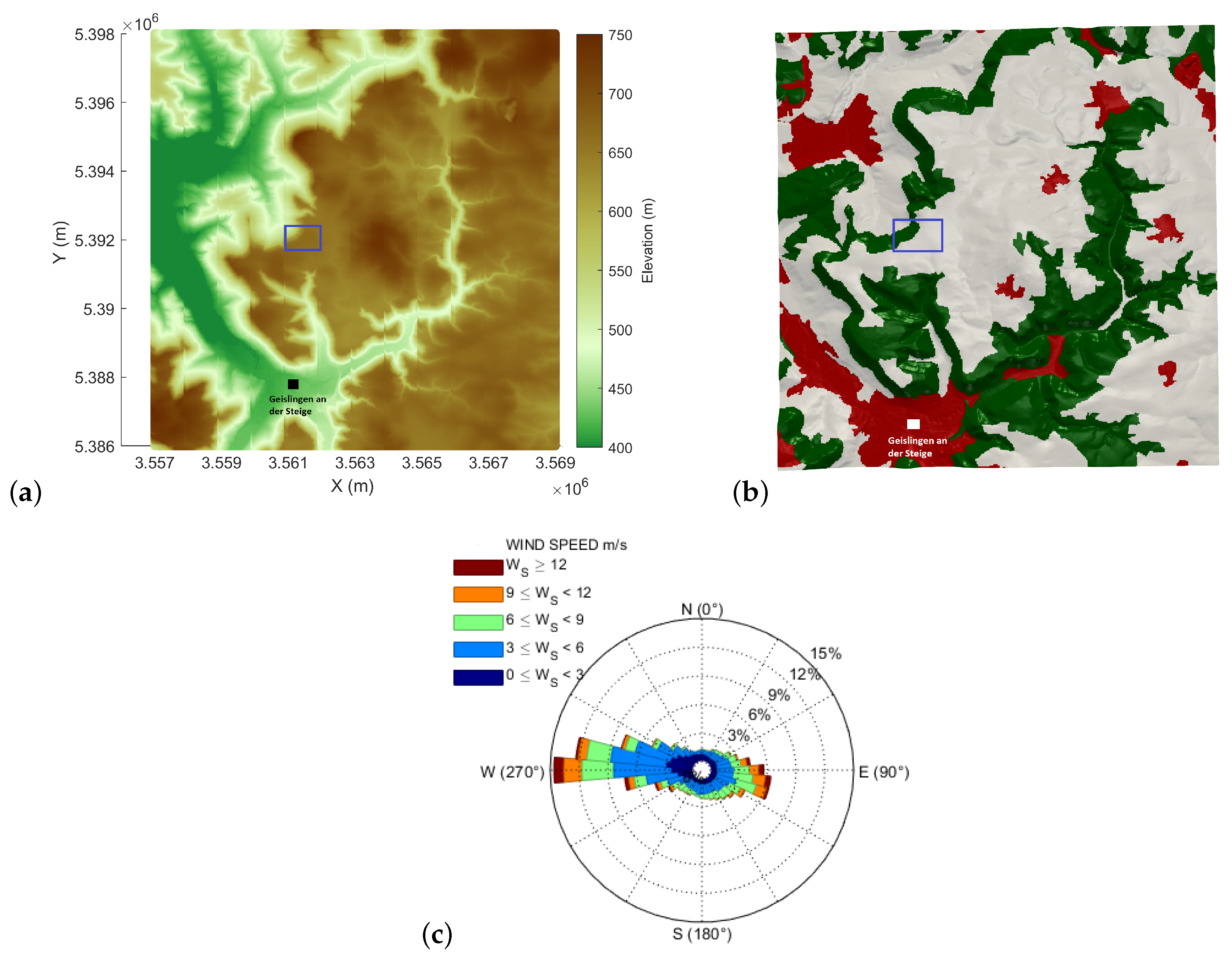
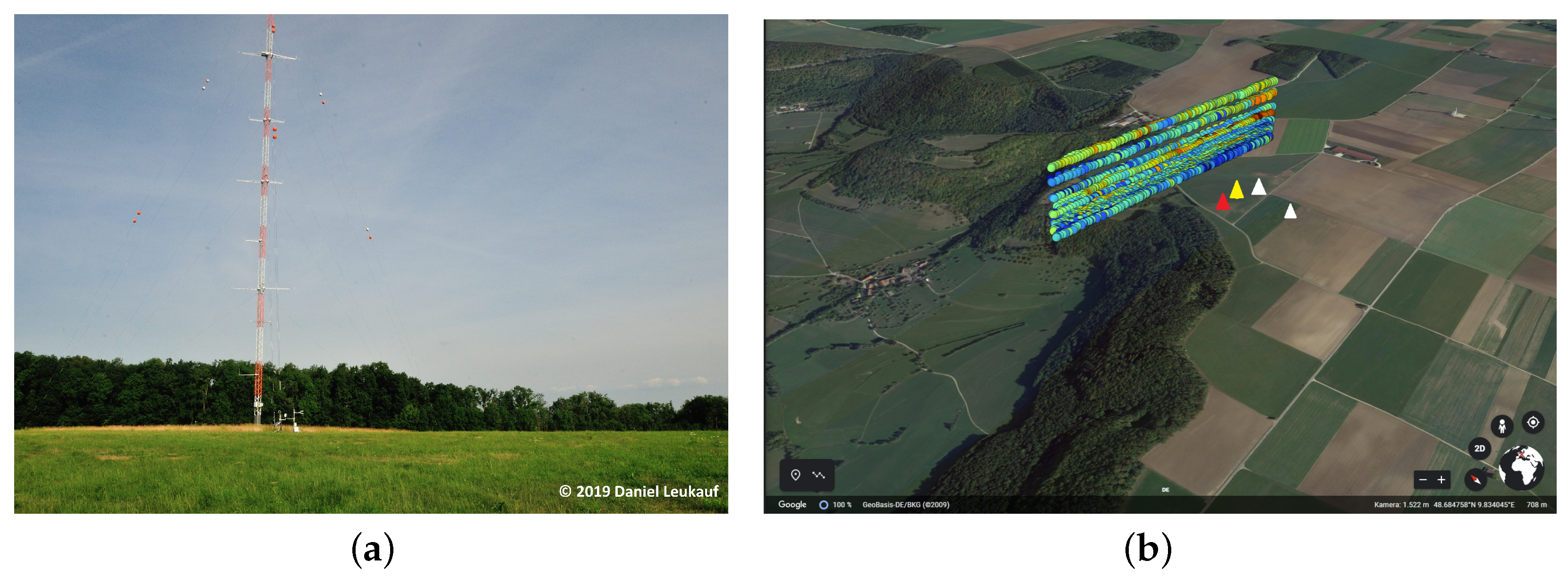
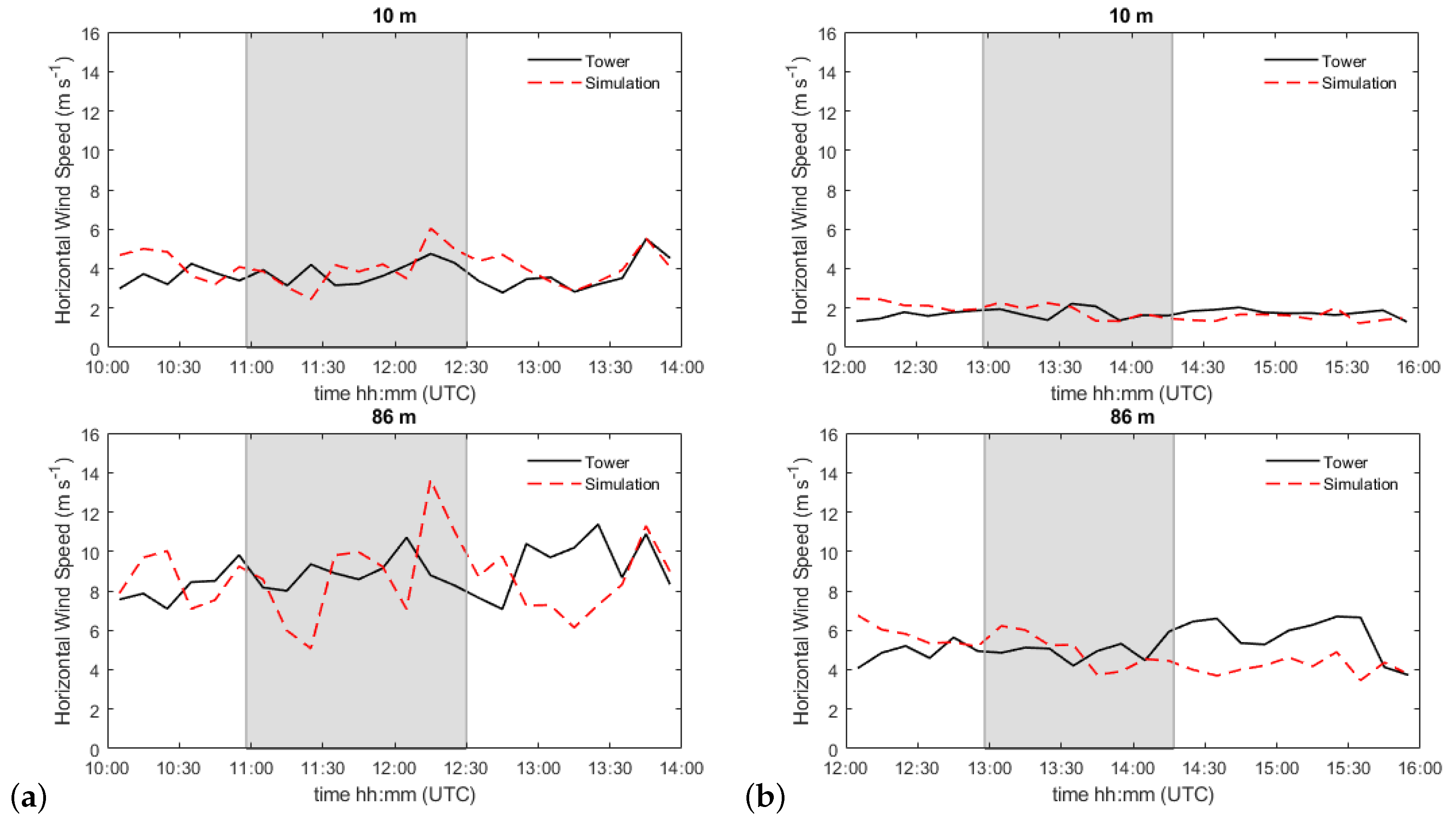
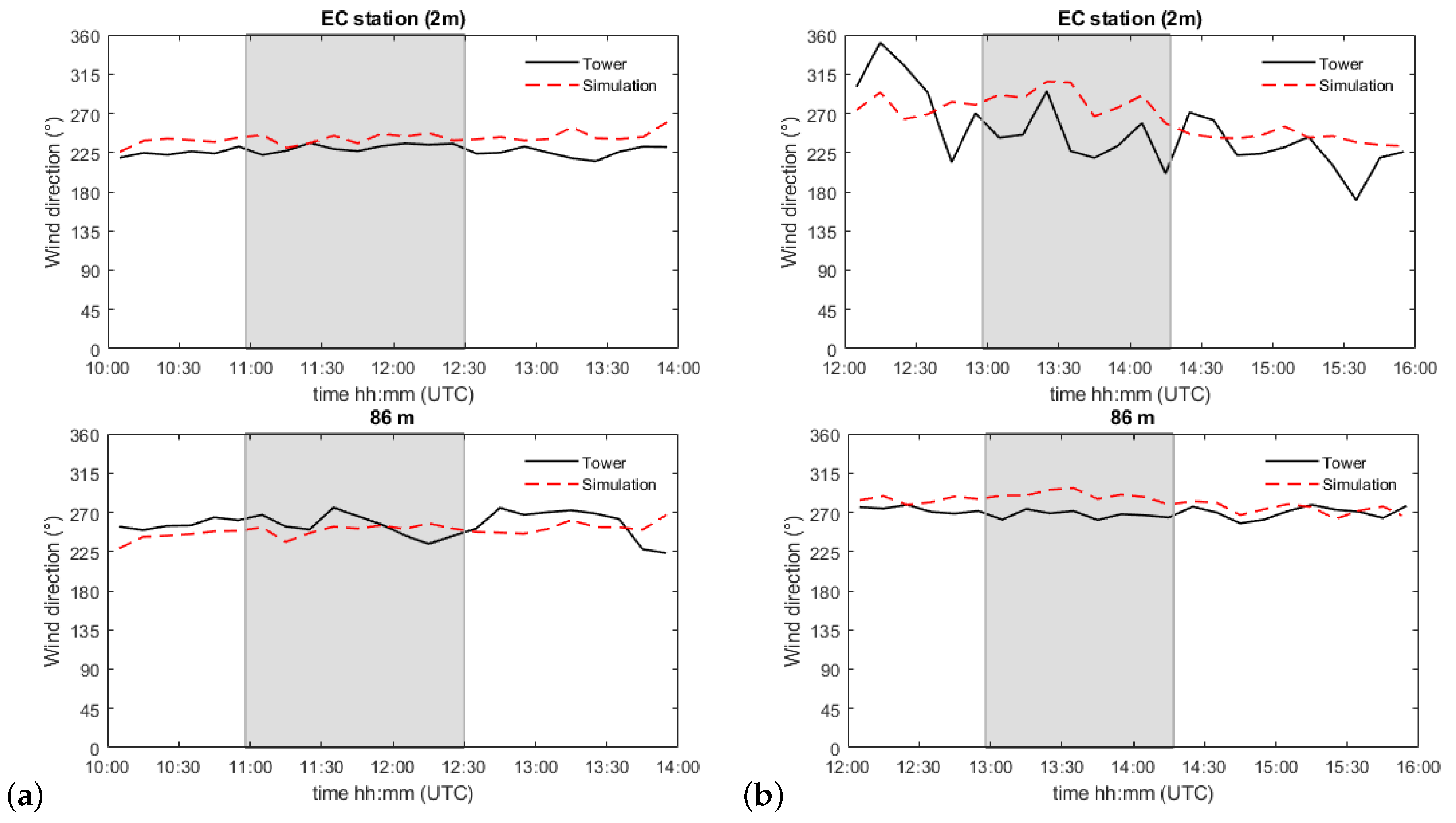



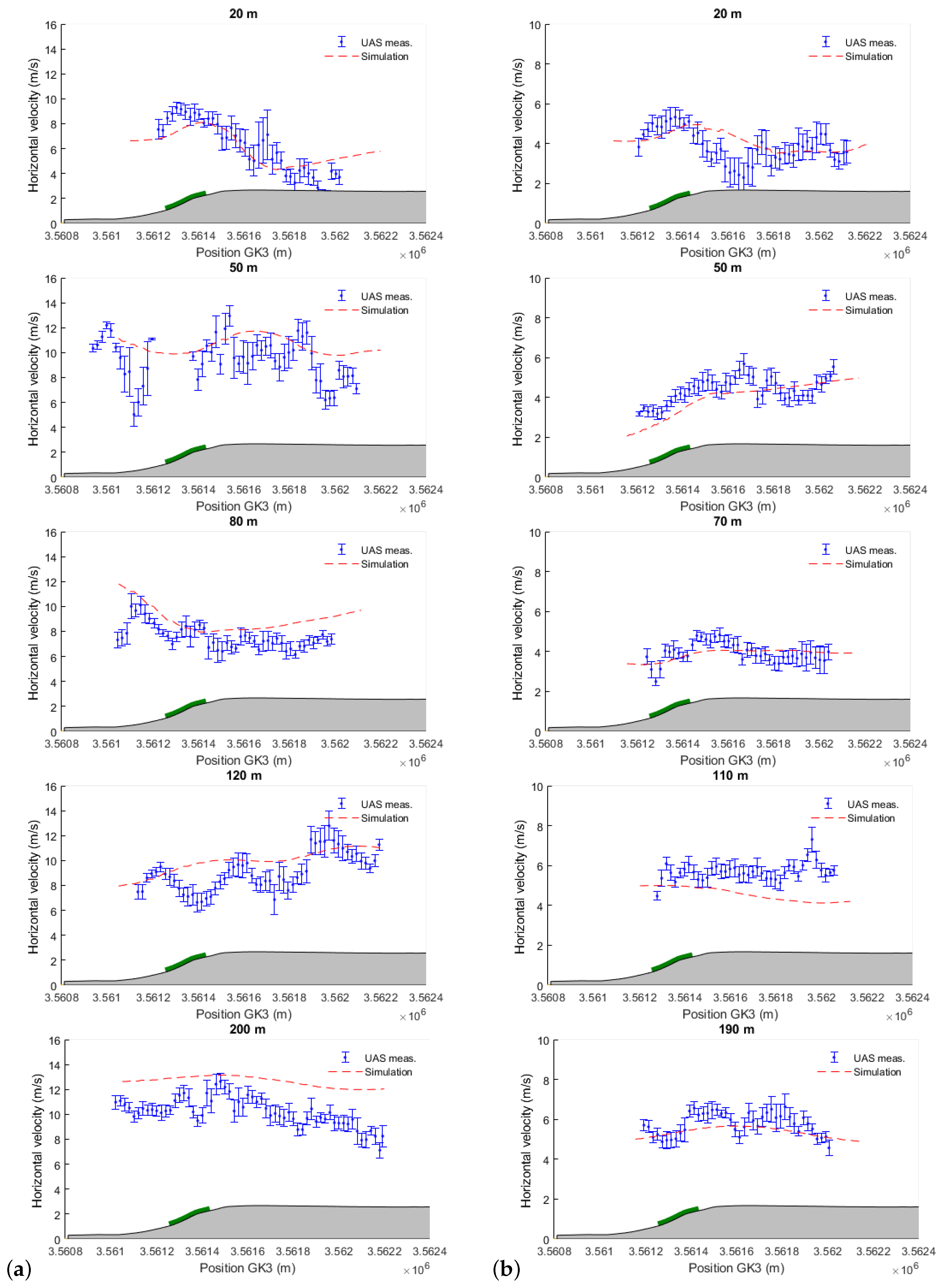
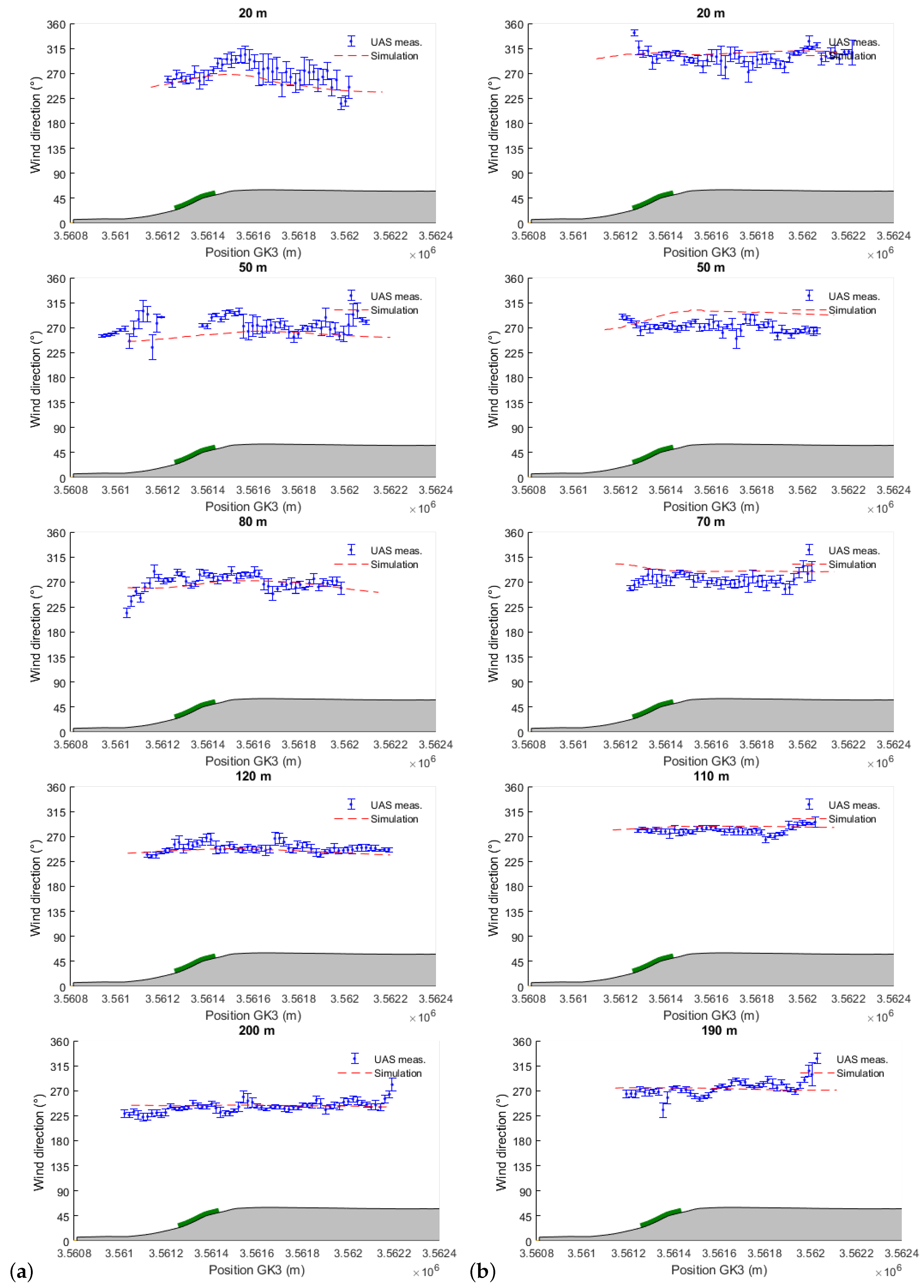





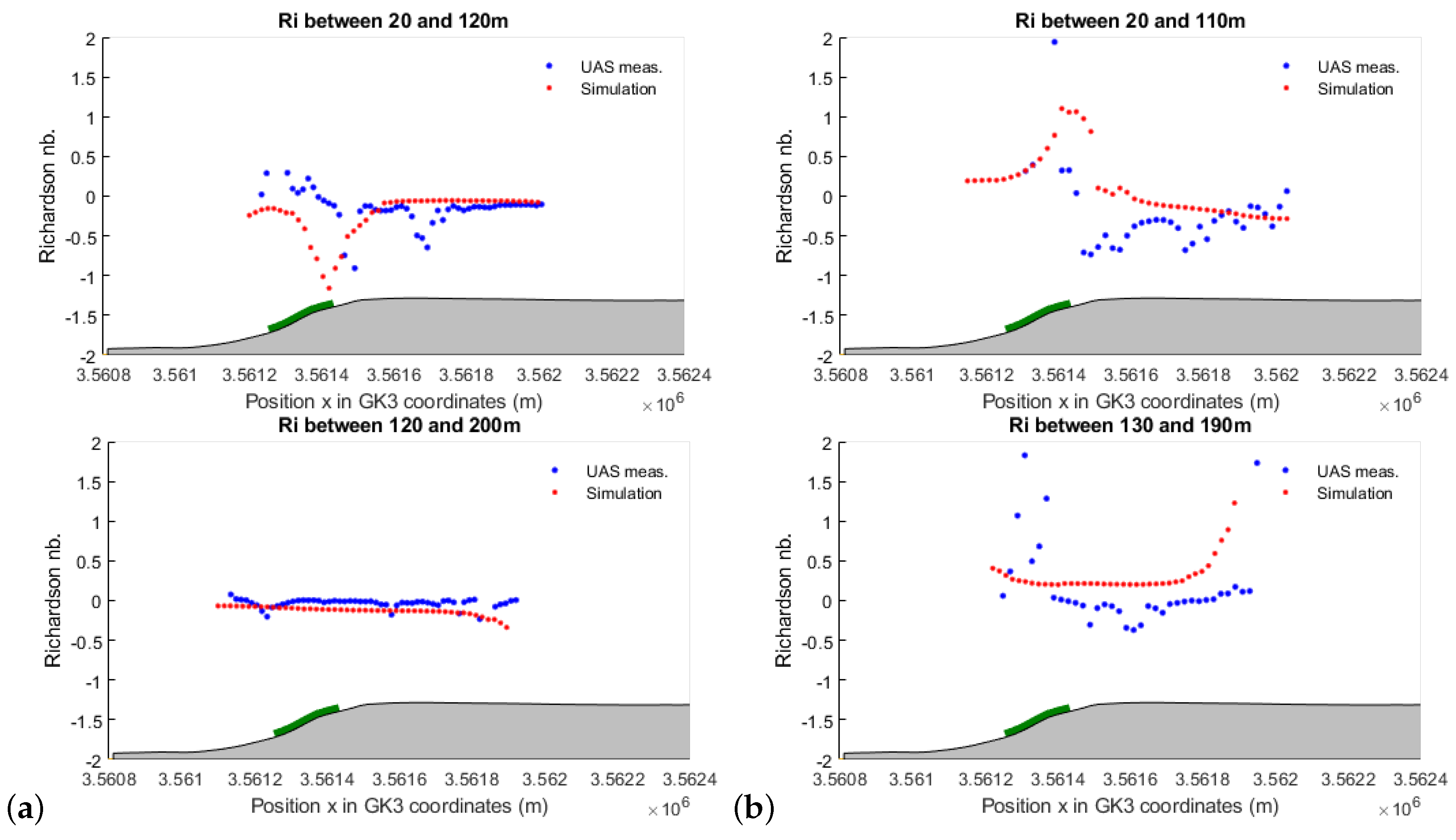
| Instrument, Mark | Location: Height above Ground Level (a.g.l.) |
|---|---|
| Cup anemometer, Thies | 10, 45, 59, 72, 86, 100 |
| Hygrothermograph, Thies | 3, 25, 45, 72, 96 |
| Barometric Pressure Transducer, Setra | 3, 96 |
| Wind Vane, Thies | 34.5, 59, 86 |
| EC station | 2 |
| MASC | 20, 30, 40, 50, 60, 70, 80, 120,130, 160, 190, 200 |
© 2020 by the authors. Licensee MDPI, Basel, Switzerland. This article is an open access article distributed under the terms and conditions of the Creative Commons Attribution (CC BY) license (http://creativecommons.org/licenses/by/4.0/).
Share and Cite
El Bahlouli, A.; Leukauf, D.; Platis, A.; zum Berge, K.; Bange, J.; Knaus, H. Validating CFD Predictions of Flow over an Escarpment Using Ground-Based and Airborne Measurement Devices. Energies 2020, 13, 4688. https://doi.org/10.3390/en13184688
El Bahlouli A, Leukauf D, Platis A, zum Berge K, Bange J, Knaus H. Validating CFD Predictions of Flow over an Escarpment Using Ground-Based and Airborne Measurement Devices. Energies. 2020; 13(18):4688. https://doi.org/10.3390/en13184688
Chicago/Turabian StyleEl Bahlouli, Asmae, Daniel Leukauf, Andreas Platis, Kjell zum Berge, Jens Bange, and Hermann Knaus. 2020. "Validating CFD Predictions of Flow over an Escarpment Using Ground-Based and Airborne Measurement Devices" Energies 13, no. 18: 4688. https://doi.org/10.3390/en13184688
APA StyleEl Bahlouli, A., Leukauf, D., Platis, A., zum Berge, K., Bange, J., & Knaus, H. (2020). Validating CFD Predictions of Flow over an Escarpment Using Ground-Based and Airborne Measurement Devices. Energies, 13(18), 4688. https://doi.org/10.3390/en13184688





